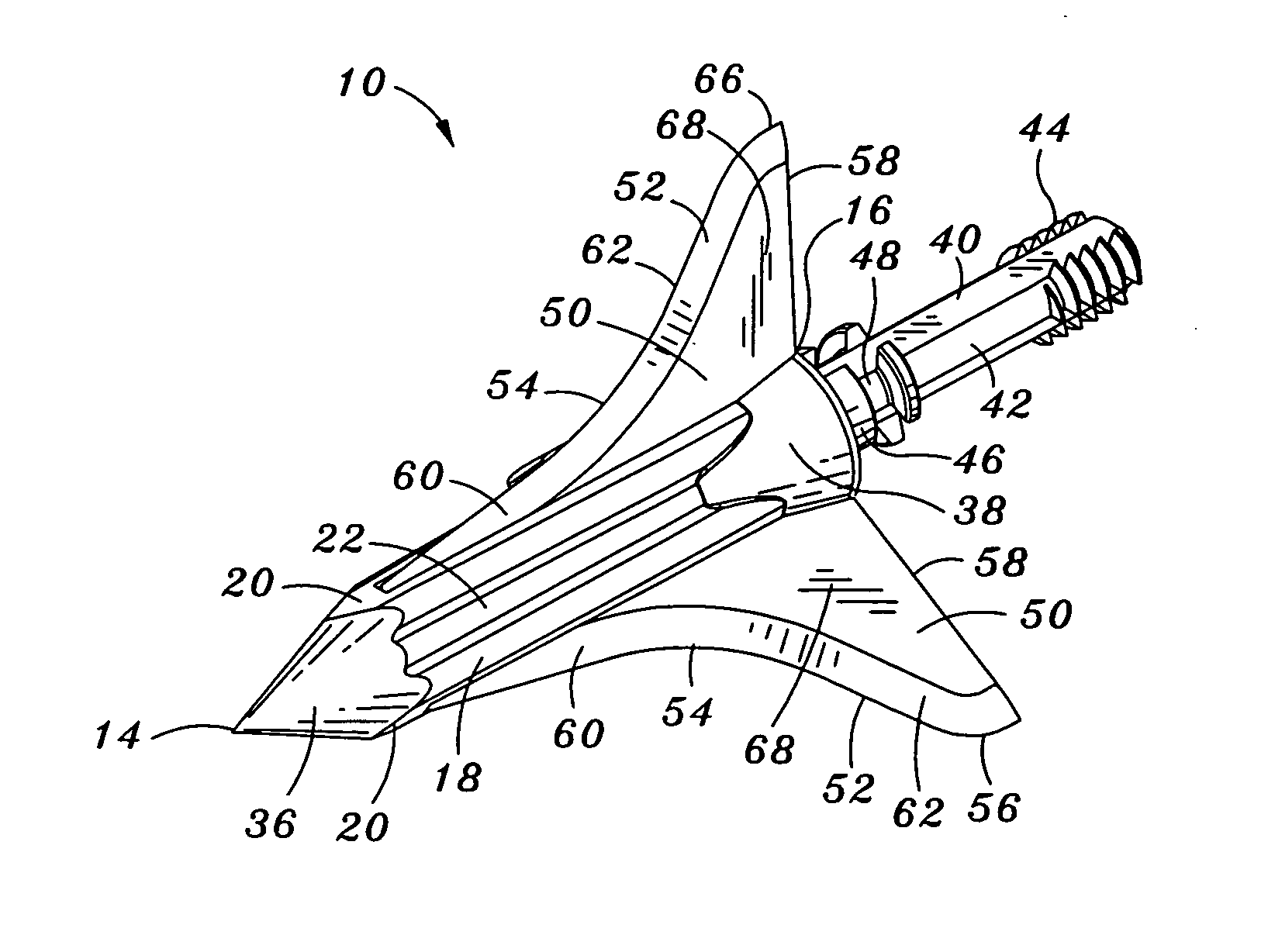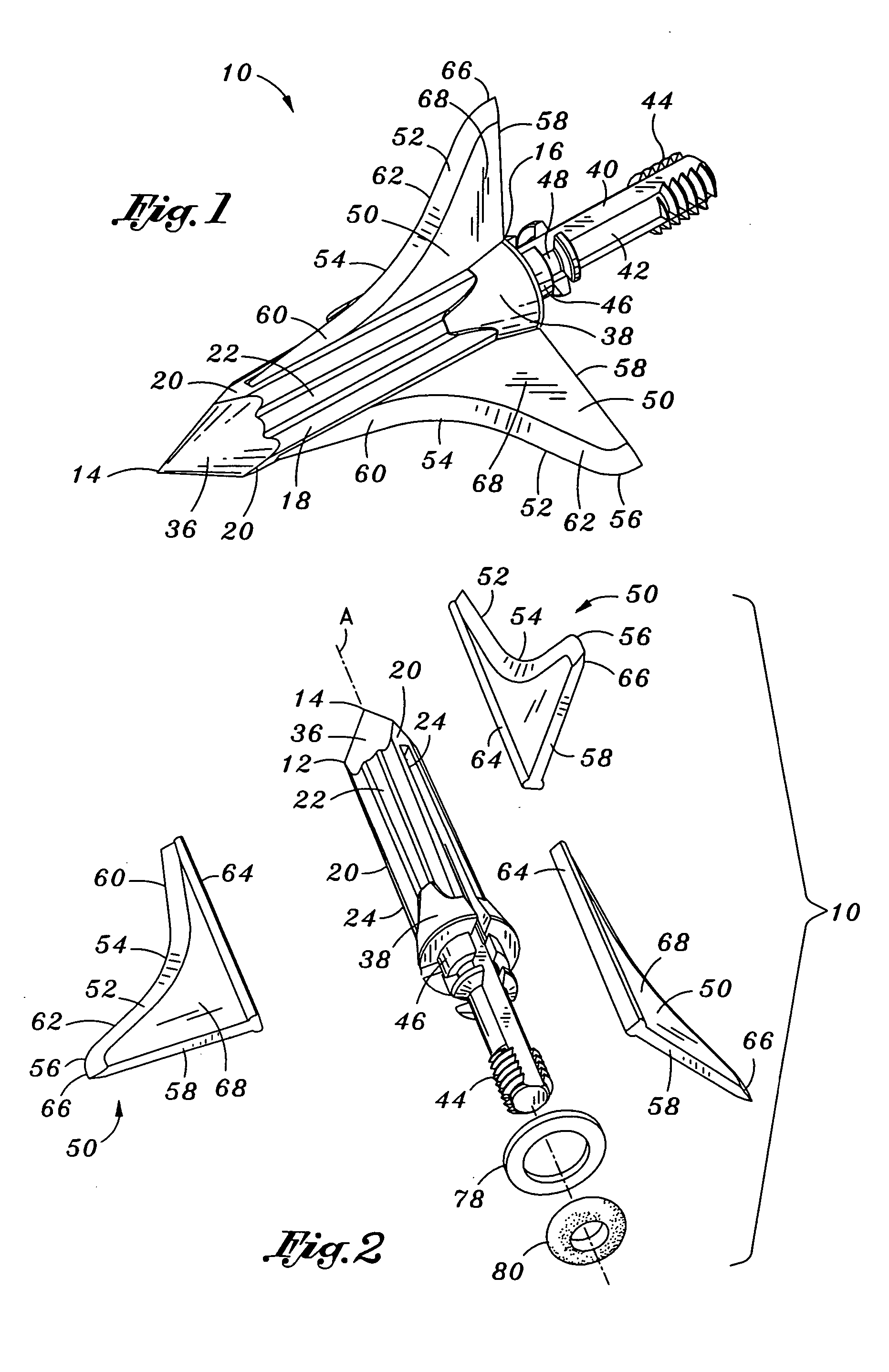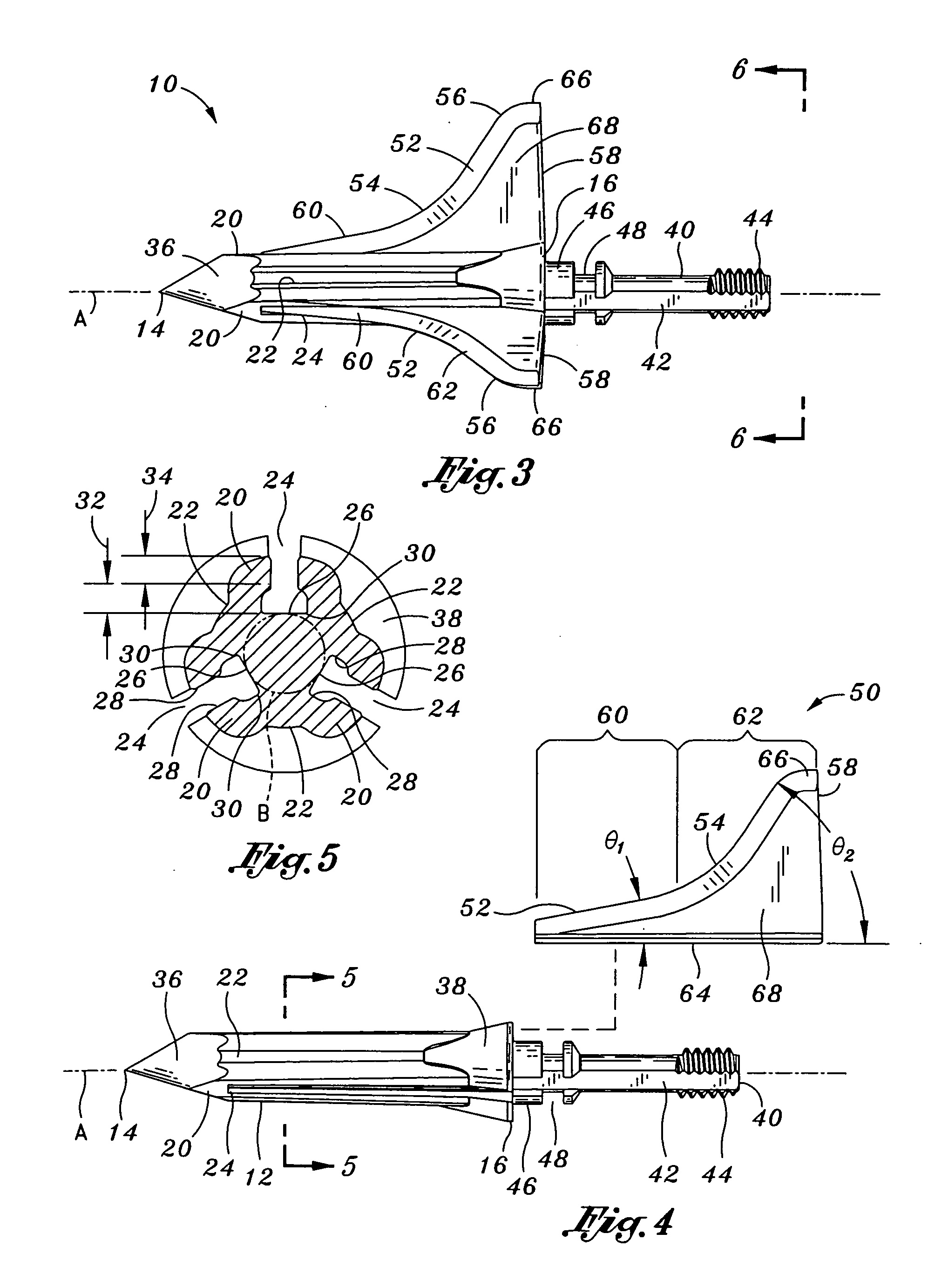Unfortunately, many broadheads of the prior art suffer from several deficiencies that detract from their overall utility.
For example, in many prior art broadheads, the connection of the blade members to the ferrule is relatively weak causing the ferrule or blade member to become damaged upon
impact with relatively hard bones of large game.
In addition, the ferrule may become damaged upon
impact with other hard surfaces such as rocks that are hit during missed shots.
Although the broadhead as disclosed in the Musacchia reference provides a relatively simple means for blade removal, the axial passageways and slots in the ferrule may greatly weaken the ferrule such that
impact with relatively hard surfaces such as bone or rocks may cause the ferrule to bend or shatter and may also result in shearing off, shattering, or splitting of the threaded-on tip.
Broadheads with threadedly attached tips are prone to misalignment which can cause arrows to veer off course.
Because Grace is understood to disclose that the as-molded T-shaped blade slots lack draft, it is believed that the ferrule cannot be effectively molded.
At best, the ferrule will experience
distortion and the mold itself will experience premature wear on the T-shaped mold inserts.
Furthermore, the base of the T-shaped blade slot base has sharp right angled inside corners which generate stress risers in the molded part and can lead to molded part distortions and failure.
In addition, the tapered triangular ferrule of Grace must be shortened in order to meet the specified weight which is an undesirable feature.
Reducing the overall ferrule length is undesirable as it causes the blade to have a steep angle which increases blade stress and can reduce penetration.
In addition, the
cutting diameter of the broadhead may need to be reduced because of the shortened ferrule length which can reduce wound channels which, in turn, reduces the effectiveness of harvesting game humanely.
The triangular cross section of the Grace ferrule causes undesirable
thin wall molding conditions, especially considering that the outside surface is slightly concave as shown between the inner T-slots and the outside surface of the ferrule which can result in a weak ferrule.
This reduced length causes the broadhead blade to be shorter which results in a steep blade angle and possibly a smaller
cutting diameter such that the effectiveness of generating wound channels may be compromised.
In Grace, the blades are shown to be triangularly shaped which can cause unpredictable flight and wind planing which results in the broadhead veering off target.
Furthermore, the T-shaped blade base is shown to have sharp right angles on all corners which provide stress risers in molded parts and increase the possibility of molding, debinding, and
sintering distortions.
Although the arrowhead of the Sorensen reference allows for blade removal for replacement or
sharpening thereof, the dovetail slot weakens the ferrule such that the ferrule may shatter upon impact with a hard surface and the separate removable tip is prone to misalignment with the ferrule.
Another deficiency associated with broadheads of the prior art is ineffective blade design.
Unfortunately, in prior art broadheads, the use of large blade members for generating extensive wound channels has an
adverse effect on flight characteristics due to wind planing (veering off course) of the arrow due to the large blade size.
Conversely, the use of small blades, while increasing the flight accuracy, results in ineffectiveness of the blade in generating wound channels.
Such
noise is undesirable in bow hunting as the
noise may startle the game when the arrow is shot.
Unfortunately, such vent openings of the Martin reference are understood to increase
noise and impede penetration of the arrow into the animal such that the effectiveness in reducing noise and generating wound channels may be compromised.
In this manner, the arrow shaft cannot plug the entrance wound made by the broadhead such that the animal may more quickly expire from
blood loss.
Another deficiency associated with removable broadheads of the prior art is relative movement between the broadhead and the arrow shaft.
However, prior art broadheads that are removably mounted on an arrow may become loosened while the arrow is resting in the bow quiver resulting in relative movement between the broadhead and the arrow.
In addition to causing a rattling noise while stalking game which may scare the game away, such relative looseness may also result in misalignment between the broadhead and the arrow which may cause the arrow to porpoise, fishtail or otherwise veer from its
flight pattern.
Furthermore, such relative looseness may allow
moisture to enter the gap between the broadhead and the arrow resulting in
corrosion of metallic mating surfaces of the broadhead and arrow shaft.
Over time, the looseness may eventually result in loss of the broadhead while being carried in the bow quiver.
Furthermore when the compliant member is deployed between the base of the broadhead ferrule and the face of the arrow insert, it can cause misalignment between the broadhead and the arrow shaft.
Another deficiency of broadheads of the prior art concerns the tuning of the bow from which the arrow is to be shot.
Unfortunately, unless a
field point is specifically manufactured to match the
mass and
balance point of a given broadhead, it is difficult to accurately tune the bow.
In addition, because field points lack blades which may be used to tightly thread the
field point into the arrow, the field point may not be tightly secured to the arrow such that, over time, relative looseness may develop between the field point and the arrow which can reduce bow tuning accuracy as well as lead to a loss of the field point.
Tuning tips of this design are prone to loosening from the arrow insert causing noise and causing an overall
distraction while practicing archery.
Tuning points of this design are weaker when compared to monolithic
solid tuning points.
The separate tip is prone to misalignment with the arrow shaft and may shear off when impacting with a hard object.
The relatively long aluminum body may lack straightness.
This arrow point is prone to vibrate loose and cause noise and unwanted
distraction while practicing archery.
These applications to the threaded connection may foul the insert and may require the arrow inserts replacement if the arrow point is to be exchanged for a different arrow point.
Uneven distribution of the
powder in the binder will result in the loss of dimensional control and cause variations in part density.
Variations in the feedstock consistency from batch to batch will also result in a loss of part dimensional control.
If a part is molded in a mold designed for a 21% part scale-up with a feedstock which actually requires a 17% scale-up, then the molded part will weigh more and be oversized.
Suitable binders for
solvent debinding can often exhibit weak greenware strength and care must be taken to prevent damage to the part prior to and during
solvent debinding.
The
solvent debinding process is very slow and it is the gating item in the PIM process.
This unfinished inventory has a negative affect with turning the unfinished inventory into revenue.
The requirement to have two debinding steps is slow and requires added capital expense.
The requirement to sinter parts at
high pressure means that an oven must be opened, parts to be sintered must be loaded and, of course, the furnace must be closed, all of which can increase the risk of part damage,
contamination and furnace seal failure.
High pressure ovens as described by Grace are prone to leak and difficult or impossible to run a
belt conveyor through which is typical of continuous processes.
It is believed that the Grace process lacks the ability to readily automate the manufacturing of broadheads and make it continuous and is largely batch oriented starting from the requirement to procure and mix, and compound two different materials.
Finally the chemicals used in chemical debinding can be caustic, damaging to the
ozone layer, and expensive to dispose of and they include substances like
chlorine and
heptane.
The PIM process as disclosed in Grace is not understood to be capable of filling the need for a
system which can be run in a continuous fashion wherein the process requires no mixing of components and thus allows for streamlining of the quality and procurement process.
 Login to View More
Login to View More  Login to View More
Login to View More 


